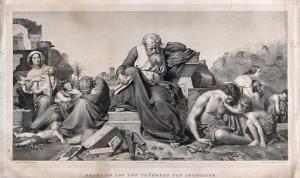Nebuchadnezzar II (c. 630-c. 561 B.C. / r. c. 605-c. 561 B.C.) (1) was perhaps the most famous king of ancient Babylonia: largely because of his status as the conqueror of the Kingdom Of Judah in 586 B.C. Bryan Windle notes about this monarch:
Nebuchadnezzar is mentioned close to 90 times in Scripture and figures prominently in the books of 2 Kings, 2 Chronicles, Jeremiah and Daniel. In Jeremiah 4:7 he is called the “destroyer of nations,” an apt description, as history records that he extended his empire through conquest such that it stretched from the Persian Gulf to the Mediterranean Sea. At its height, it included parts of modern-day Kuwait, Iraq, Syria, Jordan, Israel, Lebanon and Turkey. (2)
The Babylonian Chronicle 5; also known as the Jerusalem Chronicle, a clay tablet written in Akkadian, covers the events during Nebuchadnezzar’s reign, from the years of 605-594 B.C. It was acquired in 1896 and is held at the British Museum. (3)
2 Kings 24:8, 10, 12, 17-18 (RSV) Jehoiachin was eighteen years old when he became king, and he reigned three months in Jerusalem. . . . At that time the servants of Nebuchadnezzar king of Babylon came up to Jerusalem, and the city was besieged. . . . and Jehoiachin the king of Judah gave himself up to the king of Babylon, himself, and his mother, and his servants, and his princes, and his palace officials. The king of Babylon took him prisoner in the eighth year of his reign, . . . And the king of Babylon made Mattaniah, Jehoiachin’s uncle, king in his stead, and changed his name to Zedekiah. Zedekiah was twenty-one years old when he became king, and he reigned eleven years in Jerusalem. . . .
2 Kings 25:1-2, 6, 8-11 And in the ninth year of his reign, in the tenth month, on the tenth day of the month, Nebuchadnezzar king of Babylon came with all his army against Jerusalem, and laid siege to it; and they built siegeworks against it round about. So the city was besieged till the eleventh year of King Zedekiah. . . . Then they captured the king, and brought him up to the king of Babylon at Riblah, who passed sentence upon him. . . . In the fifth month, on the seventh day of the month — which was the nineteenth year of King Nebuchadnezzar, king of Babylon — Nebuzaradan, the captain of the bodyguard, a servant of the king of Babylon, came to Jerusalem. And he burned the house of the LORD, and the king’s house and all the houses of Jerusalem; every great house he burned down. And all the army of the Chaldeans, who were with the captain of the guard, broke down the walls around Jerusalem. And the rest of the people who were left in the city and the deserters who had deserted to the king of Babylon, together with the rest of the multitude, Nebuzaradan the captain of the guard carried into exile. (cf. Jer. 52:1-15)
Th Babylonian Chronicle 5 records Nebuchadnezzar’s initial defeat of Jerusalem in 597 B.C:
In the seventh year [598/597], the month of Kislîmu, the king of Akkad mustered his troops, marched to the Hatti-land, and besieged the city of Judah and on the second day of the month of Addarunote [February/March 597.] he seized the city and captured the king. [Jehoiachin] He appointed there a king of his own choice [Zedekiah], received its heavy tribute and sent to Babylon. (4)
The biblical texts above note that Zedekiah, the final king of Judah, reigned eleven years, under Babylonian siege, until the city and the kingdom were destroyed in 586 (or 587) B.C.: the general date accepted by virtually all scholars for the fall of Jerusalem and destruction of Solomon’s temple; though the exact year is still debated. (5) The biblical accounts above show that Nebuchadnezzar’s initial sack of Jerusalem and detention of King Jehoiachin occurred in the “eighth year” (2 Kings 24:12) of his reign (597 B.C.).
Moreover, it’s recorded that the puppet-king Zedekiah lasted eleven years (2 Kings 24:18; 2 Chron. 36:11; Jer 52:1) before the destruction of Jerusalem and its temple: in 586 B.C., and that the eleven-year siege culminating in the catastrophe of Jerusalem’s fall had already commenced by the “ninth year” (2 Kings 25:1; Jer. 52:4) of the reign of Nebuchadnezzar (596 B.C.). The year of Jerusalem’s ultimate destruction is described in the Bible (2 Kings 25:8; Jer. 52:12) as Nebuchadnezzar’s “nineteenth year” (587 or 586 B.C.).
We also have deductive and objective biblical clues as to the date of the destruction of Jerusalem, based on the biblical mention of a Jewish exile in Babylon for seventy years (Jer. 29:10; 2 Chron. 36:21) before the temple was rebuilt, and the dates of the reign of the Persian king Darius I (the Great). After interruptions (“the people of the land . . . made them afraid to build, and . . . frustrate[d] their purpose, all the days of Cyrus king of Persia, even until the reign of Darius”: Ezra 4: 4-5; “the work on the house of God which is in Jerusalem stopped”: Ezra 4:24), the final work of rebuilding the temple in Jerusalem began in “the second year of the reign of Darius king of Persia” (Ezra 4:24; cf. Hag. 1:1, 15).
In that year the Jews “began to rebuild the house of God which is in Jerusalem” (Ezra 5:2). It “was finished on the third day of the month of Adar, in the sixth year of the reign of Darius the king” (Ezra 6:15). We know that Darius the Great reigned from 522 to 486 B.C. (6) Thus, his “second year” — depending on how it is reckoned — was 521 or 520, and his “sixth year” was 517 or 516. And that is seventy years from 587 or 586: the year of the destruction of Jerusalem (give or take a year).
Conclusion: the Bible (as it has been shown to be, innumerable times) is minutely accurate in this instance, as regards the years of the initial and final destruction of ancient Jerusalem and its first temple, built by King Solomon, and also concerning when the temple was rebuilt. It’s confirmed by secular history and archaeology.
FOOTNOTES
1) Henry W.F. Saggs, “Nebuchadnezzar II,” Encyclopedia Britannica.
2) Bryan Windle, “Nebuchadnezzar: An Archaeological Biography,” Bible Archaeology Report, October 17, 2019.
3) See the British Museum page for Babylonian Chronicle 5: https://www.britishmuseum.org/collection/object/W_1896-0409-51. See texts from this tablet at the web page, “ABC 5 (Jerusalem Chronicle),” Livius.org: https://www.livius.org/sources/content/mesopotamian-chronicles-content/abc-5-jerusalem-chronicle/.
4) Windle, ibid.
5) Saggs, ibid.; Rodger C. Young, “When Did Jerusalem Fall?,” Journal of the Evangelical Theological Society 47/1 (March 2004) 21-38; C. Ermal Allen, “Jerusalem Fell in 587 Not 586 BC,” Bible and Spade 18:1 (2005). Young sums up the basis of the differences:
After suitable contacts were found linking Hebrew history to the fixed dates of the Assyrian and Babylonian empires, the greatest problem remaining was to determine the methods used by the authors who gave us the chronological data in the Scriptures. What did these authors mean when they wrote, “In the Xth year of Y king of Judah, Z became king over Israel, and he reigned W years?” Presuppositions about the method of the author will affect the interpretation of every part of such a sentence: Was the Xth year of king Y measured from his sole reign, or from his coregency? Was the year measured in an accession (non-inclusive) or non-accession (inclusive) sense? Were the years considered to start with [the Hebrew month of] Nisan in the spring or Tishri in the fall? (p. 22)
6) J. M. Munn-Rankin, “Darius I,” Encyclopedia Britannica.
***
Practical Matters: Perhaps some of my 4,200+ free online articles (the most comprehensive “one-stop” Catholic apologetics site) or fifty-one books have helped you (by God’s grace) to decide to become Catholic or to return to the Church, or better understand some doctrines and why we believe them.
Or you may believe my work is worthy to support for the purpose of apologetics and evangelism in general. If so, please seriously consider a much-needed financial contribution. I’m always in need of more funds: especially monthly support. “The laborer is worthy of his wages” (1 Tim 5:18, NKJV). 1 December 2021 was my 20th anniversary as a full-time Catholic apologist, and February 2022 marked the 25th anniversary of my blog.
PayPal donations are the easiest: just send to my email address: [email protected]. You’ll see the term “Catholic Used Book Service”, which is my old side-business. To learn about the different methods of contributing, including 100% tax deduction, etc., see my page: About Catholic Apologist Dave Armstrong / Donation Information. Thanks a million from the bottom of my heart!
***
Photo credit: Jeremiah sits amidst the rubble of Jerusalem, after its siege and destruction in 586 BC. Lithograph by Eduard Bendemann (1811–1889) [public domain / Look and Learn: History Picture Archive]
***
Summary: Archaeology and the Bible correspond, with regard to the dates of the siege and fall of Jerusalem (597 and 586 B.C.) and the date of the rebuilt temple (516 B.C.).














